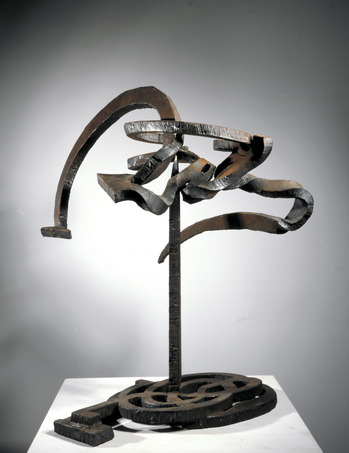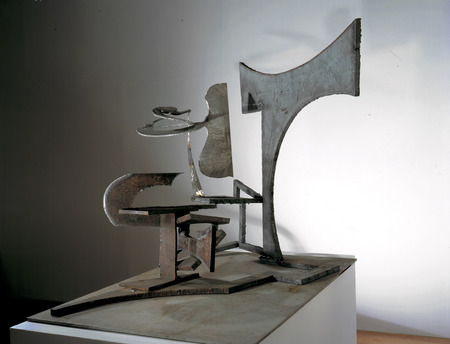UMMA exhibit showcases the smaller side of Mark di Suvero

"Maya" by Mark di Suvero
Di Suvero’s “Orion” (2006) and “Shang” (1984-85) have greatly enhanced the U-M’s main campus since the UMMA’s 2009 renovation—and Ann Arbor’s been richer for them.
“Orion,” overwhelmingly tall, bright orange, and linear with its steel fingers reaching for the sky, and the squat “Shang,” massively stocky with its heavy swinging base, are what one thinks of when one thinks of vintage di Suvero.
But the UMMA has now rounded up 17 other sculptures (and three acrylic paintings) in its “Mark di Suvero: Table Tops” exhibit in the museum’s ground level, glass-walled Irving Stenn Jr. Family Project Gallery.
This exhibit, organized from both public and private collections by the UMMA, and on view exclusively here in Ann Arbor through February 2012, features small-scaled geometric abstraction sculpture by this recent recipient of the National Medal of the Arts, conferred by President Obama last March.
What these rarely displayed tabletop sculptures show us are the varied impulses that run through all of this modern master’s artwork. For it makes sense that di Suvero wouldn’t be crafting monumental sculptures every day. It’s vastly informative for those who like their sculpture to be really big to see what this contemporary master can do with work gauged a little more to our size.
He can, and does, do quite a lot with a deliberately constricted size. As the UMMA’s gallery statement to the exhibit tells us, these works are not small approximations of larger concepts. Rather, these are works crafted with a smaller size in mind.
They give us a keen sense of how di Suvero works out the implications of his larger works by wrestling with material geared more towards an intimate setting. It’s readily apparent that size ultimately doesn’t mean that much to di Suvero as an end unto itself. And this fact alone—coupled with the convenient collaborative fact that Ann Arbor is going to be the only place to view these works in their current context—makes “Table Tops” well worth the extended study.
Granted, di Suvero’s art often looks like scraps of twisted metal and aged wood arbitrarily fused together. But the expression of his sculpture has distinct traces of 20th century modernism running through them.
Di Suvero manages to impress his personality on these varied natural and industrial components, and this muscular bending of these elements to his will makes his work stand apart from other modern sculptural talents.
Standing on the shoulders of earlier 20th century Cubists, Surrealists, and Geometric Abstractionists, di Suvero effectively sums up their explorations through his use of biomorphic and geometric abstraction. At this prestigious triangular juncture of 20th century art, di Suvero finds his mark.

"Rudder" by Mark di Suvero
“Orion’s” massive I-beam and heave gauge metal gives us a definite sense of di Suvero grappling with scale as the primary goal of his work. “Rudder,” on the other hand, playfully winds and arches gracefully in and around its defined space.
Like all great sculptors, di Suvero gives us the opportunity to study the interior and exterior volume around his construction. And what’s surprising of both works is how thoughtfully he’s calibrated his materials for viewing in the round. “Orion” overwhelms the viewer when looking up at its muscular spread while “Rudder” delights the eye with its intricate curvilinear geometric segments competing for attention.
This might as well be the art of two different sculptors—but it’s not.
Di Suvero’s “Table Tops”—like his two enormous outdoor sculptures—masterfully inhabit their environment. They illustrate the modern era’s fascination with sculptural form as a three-dimensional analog for motion. Di Suvero’s gifted touch shows us that the human hand ultimately wields power over the most massive or diminutive quantities of steel and/or wood.
“Mark di Suvero: Tabletops” will continue through Feb. 26 at the University of Michigan Museum of Art, 525 S. State St. Museum hours are 10 a.m.-5 p.m. Tuesday-Saturday, and noon-5 p.m. Sunday. For information, call 734-763-UMMA.

